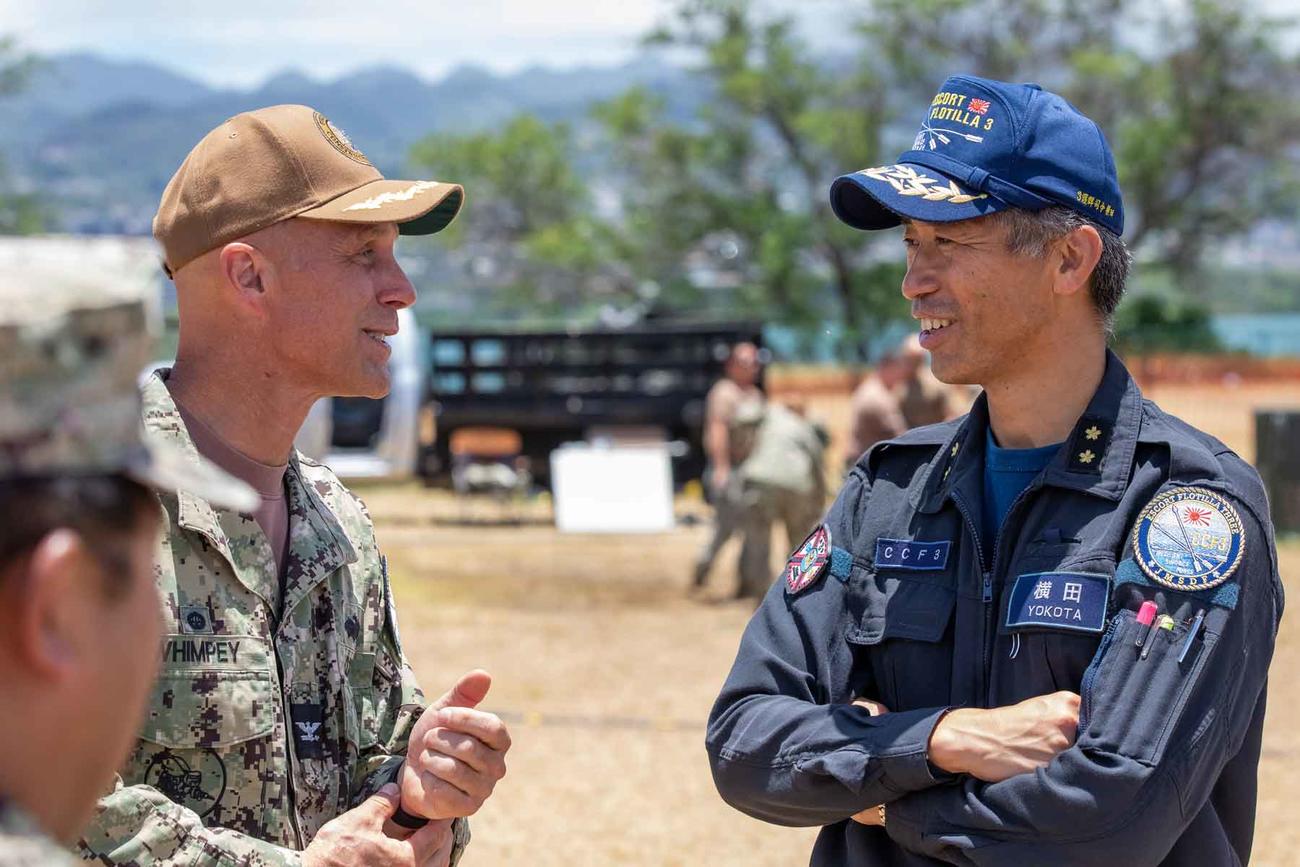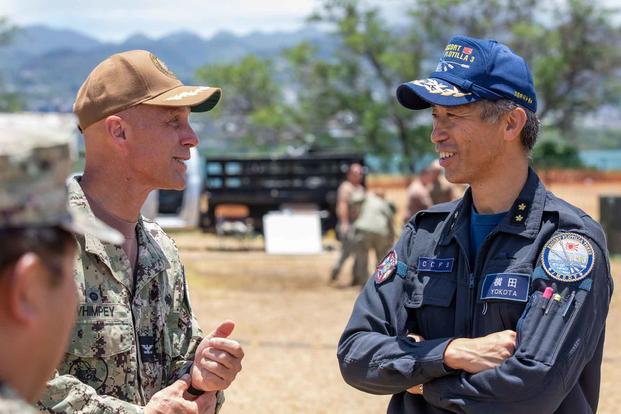

At the biennial Exercise Rim of the Pacific, the world’s largest naval training exercise, disaster response operations are growing in scale and playing a prominent role. A task force of nine countries, led by the Japan Self-Defense Forces, has been conducting operations across the Hawaiian Islands practicing search-and-rescue operations, evacuations and medical treatment in partnership with local Hawaii hospitals, emergency agencies and volunteer organizations.
“In Japan, especially in the ‘ring of fire, ’ we have lots of natural disasters, so that’s why we have a lot of experience—especially in Northeastern Japan, ” said Rear Adm. Kazushi Yokota of the Japan Maritime Defense Force, the officer in charge of humanitarian response operations at RIMPAC.
He recalled working with American forces in the real world when they assisted in the aftermath of the 2011 Pacific earthquake and tsunami that killed 19, 759 people, mostly in Japan. Yokota said, “We’ve got a lot of experience and lessons learned, so that’s why we’ve come here to share our knowledge and experience and operational ideas with other countries. And also, we can learn from other countries about their knowledge.”
RIMPAC is primarily a naval warfare exercise, but over the course of the past decade, humanitarian response training portions have grown larger.
Though military leaders are concerned about the prospect of armed conflict in the Pacific, it’s largely hypothetical. But disaster response hasn’t been hypothetical—and amid a changing climate and rising sea levels, natural disasters have been getting only more frequent and intense.
Marc Moriguchi, director of the Hawaii Healthcare Emergency Management Coalition, served as the “incident commander ” at a camp on Ford Island where simulated patients—played by a mix of local civilian and military volunteers—were preparing to get loaded into helicopters on Thursday as part of statewide training.
Military helicopters practiced taking patients from across the islands to and from hospitals in the state. Elvin Arroyo, emergency manager at Tripler Army Medical Center, said, “The way we exercise, the health care coalition comes together as a whole, and then we’re able to distribute casualties throughout the hospitals and throughout the island to ease the burden on one specific hospital. And it allows the team here to be able to triage and push casualties as hospitals are able to receive casualties.”
Arroyo was among those applying prosthetic makeup to the patients to simulate injuries. He explained, “We have anything from small lacerations, scrapes and scratches to deep wounds and open-fracture bones.
We utilize our moulage, or makeup, to try to make it as real as possible.”
The exercise is the culmination of a year’s worth of planning. But in the aftermath of a real disaster, they would have much less time to prepare. Moriguchi said. “We’re trying to do our part and get ready for a disaster and give ( Hawaii residents ) reassurance that when disaster happens, we have folks to call on to help during that disaster.”
Moriguchi said that in a place like Hawaii especially, practice is essential—as is having relationships in place before an actual disaster.
“We can’t really call anyone in the next state. The next state is California, which is 2, 500 miles away, ” Moriguchi said. “So we have to work with our partners or folks that we have here in the neighborhood in Hawaii. It is probably the only state that has all five branches of the military here, nowhere else. We’ve got to work with them, and why not do an exercise and moving people and patients ?”
Capt. Douglas Whimpey, commodore of 1st Naval Construction Regiment, leads the sailors that built the response camp on Ford Island. He said that while the mission involves the military, “it’s not a military response.” He said that in humanitarian missions the military’s job is to fill gaps and provide resources local civilian authorities might not have at their request.
Military forces are able to use their logistical experience in the immediate aftermath of disasters to quickly deliver aid, rescue people and provide engineering support. At RIMPAC this year, ships and aircraft from around the world are practicing those skills while underwater divers from the United States, South Korea and Germany are practicing how they would help reopen a port like Honolulu’s if a disaster knocked out operations.
In a first for RIMPAC, service members are also participating in urban search-and-rescue training at Marine Corps Base Hawaii. The U.S. Coast Guard’s Pacific Strike Team, which responded in the aftermath of the Aug. 8 Lahaina wildfire, is participating in that training alongside service members from South and Central America.
However, RIMPAC has been a source of controversy. This year the exercise has attracted larger-than-usual protest events in Hawaii and San Diego.
Activists have long raised concerns about the environmental impact of the exercise on Hawaii and the Pacific, particularly as ships and aircraft burn thousands, if not millions, of gallons of fuel. A 2019 report from Brown University found that the U.S. military produces more carbon emissions than many entire industrialized nations.
In a 2023 interview, Meredith Berger—the Navy’s assistant secretary in charge of energy, installations and environmental issues—acknowledged that poses a major challenge, telling the Honolulu Star-Advertiser that “we are one of the biggest users, and by association, contributors to greenhouse gases. So as we go, and we are emitting these greenhouse gases, we see the temperature change. So we are actually contributing to the increased mission set that we are responding to. So there is a cycle here.”
As part of the training scenario, the military forces responding to the disaster are delicately trying to maneuver around unfriendly forces as they operate. Whimpey said that “(if ) you have hostile nations potentially operating in close proximity to friendly nations, there’s always a chance … of some unintended escalation, and that’s an important part of the scenario so that we are able to work through all of those steps to maintain peace and stability in the region.”
In 2014 and 2016 the Chinese military attended RIMPAC and took part in humanitarian response training, but it was dis-invited in 2018 amid souring relations between Washington and Beijing as well as growing tensions between China and its neighbors in the Pacific over maritime navigation and territorial rights.
Chinese forces have harassed and occasionally attacked fishermen from neighboring countries, especially the Philippines. Those tensions have lately spilled over. In June a Philippine navy sailor was badly injured when the Chinese coast guard rammed and boarded the Philippine boat during a mission to resupply Philippine marines at an outpost on a disputed shoal.
At a trailer at the Ford Island camp, local volunteers coordinated communications with multiple radios and other communication links running. Each is meant to serve as a backup if another were to fail.
Carter Davis, a telecommunications specialist and retired Honolulu firefighter with the Hawaii Healthcare Emergency Management Coalition, said, “Nothing happens unless you get communication, for any organization. The guys with the boots on the front, they don’t get no help unless they have comms.”
Davis said that when he worked on disaster response in the 1990s, communications were overwhelmingly voice communication but that in the 2000s digitization and increased use of texting services has led to greater information technology and tech support demands.
“(Back ) then we were building simple networks, like what you put in a home, ” he said. “Now, with this cybersecurity age, networking is a whole different story.”
Davis said cyberattacks and disruption efforts, whether by criminals or foreign governments, remain a major concern even in the aftermath of tragic disasters.
“In fact, that’s probably when it’s probably the most pronounced, ” he said. “During the Maui fire the amount of social disinformation was tremendous. … That’s when they think we’re not focused on that subject. And that’s where we have to be the most focused.”
___
(c)2024 The Honolulu Star-Advertiser
Visit The Honolulu Star-Advertiser at www.staradvertiser.com
Distributed by Tribune Content Agency, LLC.
© Copyright 2024 Honolulu Star-Advertiser. All rights reserved. This material may not be published, broadcast, rewritten or redistributed.
